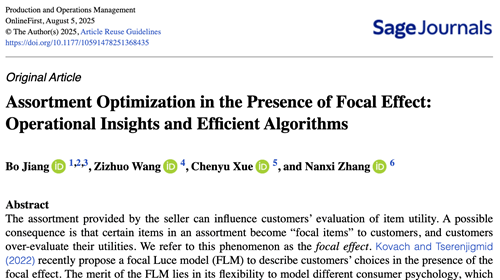Dr. XUE Chenyu Publishes Paper in Top Journal Production and Operations Management
2025-09-11
When consumers' choice behavior is significantly influenced by the assortment of products, how should merchants select the optimal product combination from a vast array of goods to maximize revenue?
Dr. XUE Chenyu from ECUST School of Business, in collaboration with Professor JIANG Bo from Shanghai University of Finance and Economics, Professor WANG Zizhuo from The Chinese University of Hong Kong, Shenzhen, and Assistant Professor ZHANG Nanxi from the Ivey Business School, Canada, conducted research on assortment and pricing decisions under the focal effect. Recently, their paper entitled "Assortment Optimization in the Presence of Focal Effect: Operational Insights and Efficient Algorithms" was published in Production and Operations Management, a top-tier journal in the field of management science.

Assortment optimization is a key strategy for merchants to select the optimal product combination from a large number of goods and maximize expected profits. Its core lies in constructing an accurate choice model to depict consumers' choice behavior and calculate the purchase probability of each product in the assortment. In reality, consumers' choices are not only affected by the inherent attributes of products but also change with the composition of the assortment. For example, a product with characteristics such as the lowest price, highest sales volume, or a special marketing positioning tends to become the focus of consumers' attention, leading to an overestimation of its attractiveness parameter. This phenomenon is called the "focal effect" and is manifested in various fields. For instance, in large supermarkets or e-commerce platforms, when there are too many product categories, consumers often tend to avoid complex decisions and instead choose the default option (such as not purchasing), the so-called "choice overload effect". The classic Multinomial Logit (MNL) choice model assumes that product attractiveness parameters are fixed, which fails to explain the above phenomena.
To address this limitation, this paper adopts the Focal Luce Model (FLM) from economics to depict consumers' choice behavior. Unlike the MNL choice model, the FLM introduces two key mechanisms: first, identifying focal products in the assortment through a focal function; second, quantifying the increment in the attractiveness of focal products through a distortion function. This model can flexibly describe various focal effect scenarios. The paper focuses on analyzing two typical cases: one is the focal effect caused by ranking—for example, products ranked high when sorted by price or sales volume are likely to become focal items. The study shows that there exists an optimal assortment with the property of "truncation-profit ranking", that is, first selecting products with attractiveness exceeding a threshold, and then supplementing the remaining products in descending order of profit, thereby balancing high attractiveness and high profit. The other is the scenario with fixed focal products, such as the choice overload effect. In this case, different products have different profit thresholds for entering the optimal assortment, exhibiting the property of "floating thresholds". The study also finds that as the choice overload effect intensifies, the optimal assortment may expand by introducing more high-attractiveness products to offset the loss caused by consumers switching to the "not purchasing" option. Although this type of assortment optimization is an NP-hard problem, it can still be solved in polynomial time under a specific distortion function structure.
On this basis, the paper further investigates the joint optimization problem of assortment and pricing, and transforms the original problem into a one-dimensional root-finding problem for efficient solution. Numerical experiments based on real datasets show that the FLM significantly outperforms the MNL model in predicting consumers' choice behavior, and performs equivalently or even better than more complex models in terms of profit improvement. In general, the FLM can not only flexibly depict consumers' choice mechanisms in different contexts but also maintain polynomial-time solvability under the condition of reasonably setting the focal function and distortion function. This model and related algorithms are expected to provide merchants with more accurate revenue management tools in the future, helping them cope with the volatile market environment and consumer psychology. It also has important strategic value for enterprises in formulating differentiated marketing strategies and achieving long-term profit maximization.

XUE Chenyu is a faculty member of the Department of Management Science and Engineering, School of Business, ECUST. Her main research interests include revenue management, optimization theory, and algorithms.
Paper Information
Bo Jiang, Zizhuo Wang, Chenyu Xue, Nanxi Zhang. Assortment Optimization in the Presence of Focal Effect: Operational Insights and Efficient Algorithms. Production and Operations Management, In Press.
Link:https://journals.sagepub.com/doi/10.1177/10591478251368435
